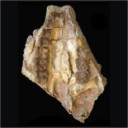
|
A new species of Propalaeotherium (Palaeotheriidae, Perissodactyla, Mammalia) from the Middle Eocene locality of Aumelas (Hérault, France).
Keywords:
Eocene; new species; Palaeotheriidae; Propalaeotherium
doi: 10.18563/pv.40.2.e1
Cite this article:
Remy J.-A., Krasovec G., Marandat B., 2016. A new species of Propalaeotherium (Palaeotheriidae, Perissodactyla, Mammalia) from the Middle Eocene locality of Aumelas (Hérault, France). Palaeovertebrata 40 (2)-e1. doi: 10.18563/pv.40.2.e1
Export citation
Abstract
A new Propalaeotherium species, clearly distinct from the genus Eurohippus, is described. It is characterized by having a similar size as P. voigti from the German Geiseltal localities (MP 11 to MP 13 reference-level), but differs in several features suggesting a slighty more derived morphology. It presents indeed less brachyodont crowns with less prominent and less elevated cingula, slightly larger relative surface of premolars, and a more marked metaconid splitting on cheek teeth. This new species is unknown from other European localities except the nearby Saint-Martin de Londres locality which has been considered older than the MP 13 level.
Published in Vol.40-2 (2016)
Bibliography
BiochroM’97 (collective), 1997. Synthèses et Tableaux de corrélations. In: Aguilar, J.-P., Legendre, S., Michaux, J. (Eds.), Actes du Congrès BiochroM’97. Mémoires et Travaux de l’EPHE, Institut de Montpellier, 769-805.
Crochet, J.-Y., 1979. Diversité systématique des didelphidés (Marsupiala) européens tertiaires. Géobios 11 (3), 365-378. http://dx.doi.org/10.1016/S0016-6995(79)80117-5
Crochet, J.-Y., Godinot, M., Hartenberger, J.-L., Remy, J. A., Sigé, B., Sudre, J., 1988. Découverte dans le bassin de St-Martin-de-Londres (Hérault, Sud de la France) d’un gisement à vertébrés continentaux d’âge Eocène moyen. Courier Forschungsinstitut Senckenberg 107, 419-434.
Escarguel G. 1999. Les Rongeurs de l’Eocène inférieur et moyen d’Europe occidentale. Systématique, phylogénie, biochronologie et paléobiogéographie des niveaux-repères MP 7 à MP 14. Palaeovertebrata 28 (2-4), 89-351.
Franzen, J. L., 2006. Eurohippus n. g., a new genus of horses from the Middle to Late Eocene of Europe. Senckenbergiana Lethaea 86 (1), 97-102. http://dx.doi.org/10.1007/BF03043638
Franzen, J. L., Haubold, H., 1986. Revision der Equoidea aus den eozänen Braunkohlen des Geiseltales bei Halle (DDR). Palaeovertebrata 16 (1), 1-34.
Froehlich, D. J., 2002. Quo vadis eohippus? The systematics and taxonomy of the early Eocene equids (Perissodactyla). Zoological Journal of the Linnean Society 134, 141-256. http://dx.doi.org/10.1046/j.1096-3642.2002.00005.x
Godinot, M., 1988. Les primates adapidés de Bouxwiller (Eocène Moyen, Alsace) et leur apport à la compréhension de la faune de Messel et à l’évolution des Anchomomyini. Courier Forschungsinstitut Senckenberg 107, 383-407.
Hartenberger, J.-L., 1963. Un gisement de la zone de Mammifères d’Issel (Eocène moyen) dans les calcaires lacustres d’Aumelas (Hérault). Comptes-rendus sommaires de la Société Géologique de France 9, 321-322.
Hooker, J. J., 1986. Mammals from the Bartonian (middle/late Eocene) of the Hampshire Basin, southern England. Bulletin of The British Museum (Natural History) Geology 39 (4), 191-478.
Lalaï, D., 1982. Étude systématique du Lophiodon du gisement d’Aumelas, Unpublished Master thesis, Université de Montpellier, Montpellier, 1-79.
Laurillard, C. L., 1849. [Various articles on fossil vertebrates]. In: D’Orbigny, C. (Ed.), Dictionnaire universel d’histoire naturelle, Paris.
Maitre, E., 2014. Western European middle Eocene to early Oligocene Chiroptera: systematics, phylogeny and palaeoecology based on new material from the Quercy (France). Swiss Journal of Palaeontology 133, 141-242. http://dx.doi.org/10.1007/s13358-014-0069-3
Maitre, E., Sigé, B. Escarguel, G., 2006. Amphilemuridae (Lipotyphla, Mammalia) éocènes d’Europe occidentale : nouvelles données taxonomiques. Comptes Rendus Palevol 5, 813-820. http://dx.doi.org/10.1016/j.crpv.2006.01.005
Maitre, E., Escarguel, G., Sigé, B., 2008. Amphilemuridae éocènes d’Europe occidentale - Nouvelles données, formes affines, systématique et phylogénie. Palaeontographica Abteilung A 283 (1-3), 35-82.
Remy, J. A., 1976. Étude comparative des structures dentaires chez les Palaeotheriidae et divers autres Périssodactyles fossiles. Unpublished PhD thesis, Université Strasbourg I.
Remy, J. A., 1988. Le gisement du Bretou (Phosphorites du Quercy, Tarn-et-Garonne, France) et sa faune de vertébrés de l’Eocène supérieur. VIII. Périssodactyles. Palaeontographica A 205, 155-172.
Remy, J. A., 2015. Les Périssodactyles (Mammalia) du gisement Bartonien supérieur de Robiac (Éocène moyen du Gard, Sud de la France). Palaeovertebrata 39 (1)-e3, 1-98. http://dx.doi.org/10.18563/pv.39.1.e3
Savage, D. E., Russell, D. E., Louis, P., 1965. European Eocene Equidae (Perissodactyla). University of California Publications in Geological Sciences 56, 1-94.
Stehlin, H. G., 1904. Die Säugetiere des schweizerischen Eocaens. Critisher Catalog der Materialen. 2er Teil. Abhandlungen der schweizerischen paläontologischen Gesellschaft 31, 154-445.
Sudre, J., 1978. Les Artiodactyles de l’Eocène moyen et supérieur d’Europe occidentale (systématique et évolution). Mémoires et Travaux de l’E.P.H.E., Institut de Montpellier 7, 1-229.
Sudre, J., 1980. Aumelasia gabineaudi n.g. n.sp. nouveau Dichobunidae (Artiodactyla, Mammalia) du gisement d’Aumelas
(Hérault) d’âge Lutétien terminal. Palaeovertebrata, Mémoire Jubilaire R. Lavocat, 197-211.
Sudre, J., 1988. Apport à la connaissance du Dichobune robertiana Gervais, 1848-1852 (Mammalia, Artiodactyla) du Lutétien: considération sur l’évolution des Dichobunidés. Courier Forschungsinstitut Senckenberg 107, 409-418.
|
PDF |
S.I. Data |
